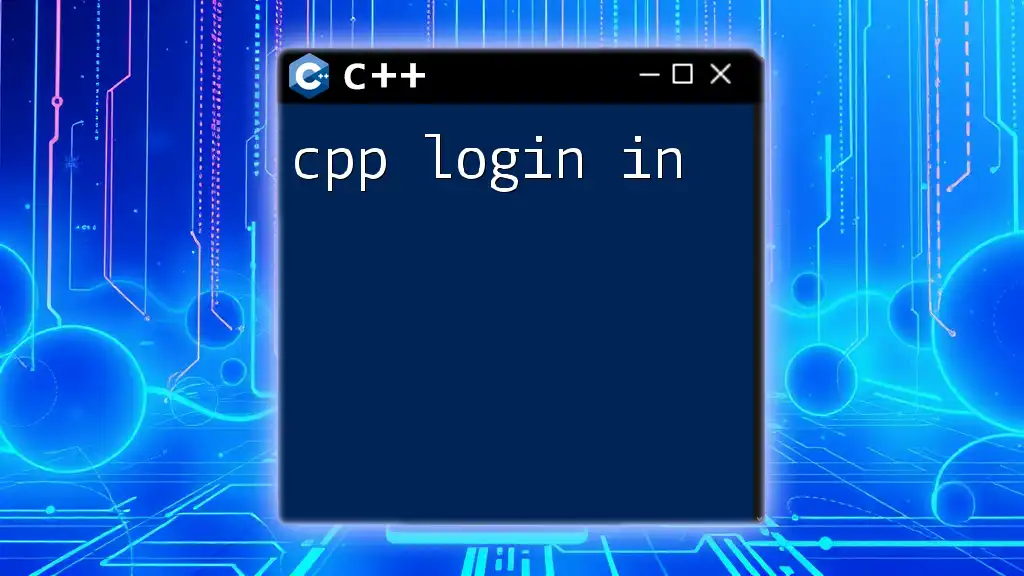In C++, a simple login system can be created using basic input-output functions to authenticate a user with a predefined username and password.
#include <iostream>
#include <string>
int main() {
std::string username = "user";
std::string password = "pass";
std::string inputUsername, inputPassword;
std::cout << "Enter username: ";
std::cin >> inputUsername;
std::cout << "Enter password: ";
std::cin >> inputPassword;
if (inputUsername == username && inputPassword == password) {
std::cout << "Login successful!" << std::endl;
} else {
std::cout << "Login failed, please try again." << std::endl;
}
return 0;
}
Understanding User Authentication
What is User Authentication?
User authentication is the process of verifying the identity of a user who is trying to access a system or application. It is crucial for ensuring that only authorized users can access certain data or functionalities. In the context of C++ development, understanding how to implement a secure login system is fundamental for any application that handles confidential information.
Basic Principles of User Authentication
When creating a login system using C++, it is vital to consider several key principles: confidentiality, integrity, and availability. By ensuring confidentiality, you make certain that only authorized users can view confidential information. Integrity guarantees that the information cannot be altered by unauthorized individuals, while availability ensures that there is no downtime preventing legitimate users from accessing the system.
Setting Up Your C++ Environment
Required Tools and Libraries
To implement a C++ login system, you will need an efficient development environment. Popular choices include Code::Blocks, Visual Studio, or any other C++ IDE that suits your needs. Make sure to include essential libraries like `iostream` for input and output operations and `fstream` for handling file-based user credential storage.
Core Concepts for Login Functionality
Input Handling
Taking user input effectively is the first crucial step in developing a login feature. Use C++'s `std::getline` to capture username and password input securely. This method avoids complications that arise from spaces being part of the input.
std::string username;
std::string password;
std::cout << "Enter username: ";
std::getline(std::cin, username);
std::cout << "Enter password: ";
std::getline(std::cin, password);
Storing User Credentials
How and where you store user credentials is critical for security. Storing usernames and hashed passwords in simple text files is a straightforward method, but always ensure that these files are not easily accessible. The file structure might look like:
username1:hashed_password1
username2:hashed_password2
Hashing Passwords
To protect user passwords effectively, they should never be stored in plain text. Instead, employ a hashing function to convert passwords into fixed-length strings that do not reveal their original forms.
Here's an example of a fictional password-hashing function:
std::string hashPassword(const std::string &password) {
// This is a placeholder for actual hashing logic
return "hashed_" + password;
}
Creating the Login Function
Structuring the Login Function
The login function needs to compare the user input with stored credentials. This function should return `true` for a successful login and `false` otherwise.
A simple implementation could look like this:
bool login(const std::string &username, const std::string &password) {
// Logic to compare input with stored credentials
std::string stored_password = getStoredPassword(username); // Assume this function fetches the password
return hashPassword(password) == stored_password;
}
This function retrieves the hashed password for the provided username and checks if it matches the hash of the entered password.
Integrating User Feedback
User feedback is essential for a robust user experience. Always inform the user whether the login was successful or if there was an error. For example:
if (login(username, password)) {
std::cout << "Login successful! Welcome, " << username << ".\n";
} else {
std::cout << "Login failed! Please check your username and password.\n";
}
Handling Security Concerns
Implementing Input Validation
Validating user input is a significant part of any secure login process. Make sure that usernames and passwords meet specific criteria, such as length and character restrictions, to help prevent SQL injection and other attacks.
Rate Limiting Login Attempts
To enhance security, implement a mechanism that limits the number of login attempts. This method helps protect against brute-force attacks. You can initialize a counter for login attempts and increase it each time a login fails, locking the account after a predetermined number of attempts.
Secure Communications
While not specific to C++ alone, ensure that your application’s communication channels are secure. Consider using SSL/TLS for any data transmission, especially during the login process, to encrypt sensitive information.
Testing Your Login Function
Developing Test Cases
Thorough testing of the login functionality is paramount. Create test cases that cover various scenarios, such as valid inputs, incorrect usernames, and wrong passwords. This will help ensure the robustness of your login system.
Sample Test Code
Here’s a simple test function to validate the login logic:
void testLogin() {
assert(login("user1", "correct_password") == true);
assert(login("user1", "wrong_password") == false);
}
This will help you verify that the login function behaves as expected under different circumstances.
Conclusion
Implementing cpp login in involves understanding user authentication, securely handling user input, storing credentials wisely, and ensuring that your code adheres to best security practices. By following the guidelines in this comprehensive guide, you will be well-equipped to develop a secure login system in your C++ applications.
Additional Resources
For further learning, consider diving into reputable C++ programming books, online courses, or detailed documentation to expand your understanding of user authentication and security best practices.








